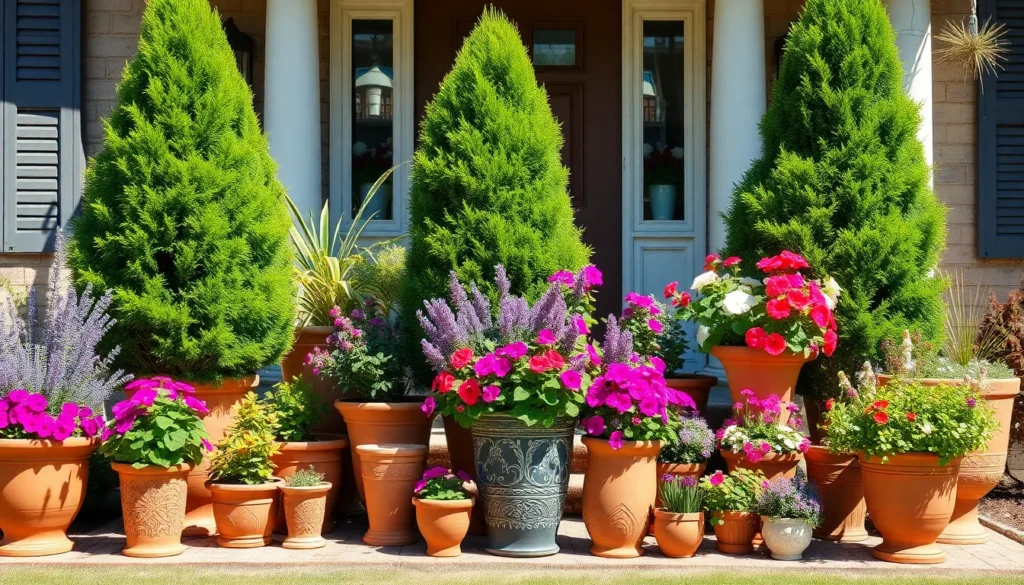We’ve all walked past a stunning front yard and wondered what made it so captivating. The secret often lies in strategically placed potted plants that transform ordinary spaces into welcoming outdoor sanctuaries. Front yard container gardening isn’t just about curb appeal – it’s about creating an inviting entrance that reflects your personality while boosting your home’s value.
Potted plants offer unmatched flexibility compared to traditional landscaping. We can easily rearrange containers to refresh our front yard’s look with the seasons or move tender plants indoors when temperatures drop. This approach works perfectly for renters or anyone who wants beautiful landscaping without permanent commitment.
Whether you’re working with a tiny porch or a sprawling entrance, the right combination of containers and plants can dramatically enhance your home’s first impression. From dramatic statement pieces to charming clusters of smaller pots, we’ll show you how to create a front yard that stops traffic for all the right reasons.
Choose the Right Containers for Your Front Yard Potted Plants
Selecting appropriate containers forms the foundation of successful front yard container gardening. We’ll explore the essential factors that determine which pots work best for your outdoor space.
Consider Size and Drainage Requirements
Larger containers provide better stability and root space for your front yard displays. We recommend choosing pots that are at least 12 inches wide for small plants like herbs and annual flowers, while shrubs and small trees need containers measuring 18 to 24 inches across. Deep pots work especially well for plants with extensive root systems such as tomatoes, peppers, and ornamental grasses.
Drainage holes prevent waterlogged soil that can kill your plants within days. Every container needs multiple holes in the bottom, typically one hole per 6 inches of pot diameter. We suggest drilling additional holes if your chosen containers don’t have enough drainage. Adding a layer of gravel or broken pottery shards at the bottom improves water flow and prevents soil from washing out.
Weight considerations matter when positioning containers in your front yard. Terra cotta and ceramic pots become extremely heavy when filled with wet soil, making them difficult to move seasonally. We often use lightweight alternatives like fiberglass or resin for larger statement pieces that we might need to relocate.
Select Weather-Resistant Materials
Fiberglass containers withstand freeze-thaw cycles better than most other materials. These modern options resist cracking, fading, and warping while maintaining their appearance for 10 to 15 years. We’ve found that high-quality fiberglass pots can mimic the look of stone, wood, or ceramic at a fraction of the weight.
Resin and plastic containers offer budget-friendly durability for front yard plantings. UV-resistant versions won’t fade or become brittle in direct sunlight, lasting 5 to 8 years with proper care. We recommend choosing thicker-walled options that won’t crack during winter months or blow over in strong winds.
Natural materials require seasonal protection in harsh climates. Terra cotta pots can crack when water freezes inside them, while wooden containers may rot without proper sealing. We suggest moving these containers to protected areas during winter or treating them with weatherproofing products annually.
Match Container Style to Your Home’s Architecture
Traditional homes pair beautifully with classic container shapes like urns, barrel planters, and decorative ceramic pots. We choose containers with ornate details, curved lines, and rich colors that complement brick, stone, or wood siding. Symmetrical arrangements of matching pots create formal elegance that enhances colonial, Victorian, or craftsman-style exteriors.
Modern architecture calls for clean-lined containers with geometric shapes and neutral colors. Rectangular planters, cylindrical pots, and cube-shaped containers work perfectly with contemporary homes featuring metal, glass, or concrete elements. We often select black, white, or gray containers that won’t compete with bold architectural features.
Rustic and farmhouse styles benefit from natural materials like weathered wood, galvanized metal, or distressed finishes. We incorporate vintage-inspired containers such as metal watering cans, wooden crates, and aged terra cotta pots that add character without overwhelming the home’s casual charm. Mixing different heights and textures creates visual interest while maintaining the relaxed aesthetic.
Select Plants That Thrive in Containers
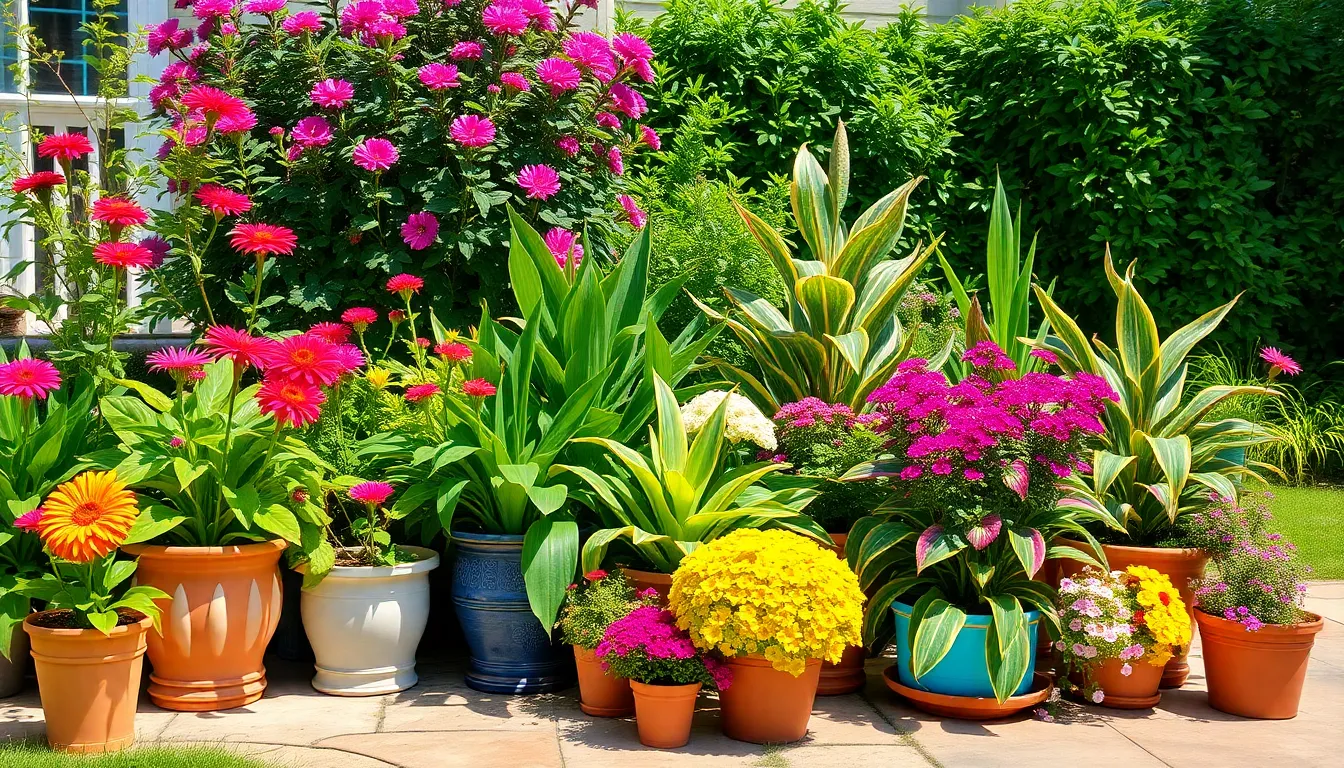
Now that we’ve chosen the perfect containers for our front yard, it’s time to fill them with plants that’ll truly flourish in a potted environment.
Pick Plants Suited to Your Climate Zone
Gomphrena thrives in zones 9-11 and delivers impressive heat tolerance that makes it perfect for sunny container displays. We can grow this colorful globe-shaped flower as an annual in cooler zones where it won’t survive winter temperatures. Lantana performs exceptionally well in warm climates as a perennial but works beautifully as an annual in regions with frost.
Tropical specimens like banana trees and palm trees create stunning focal points in containers when we live in warm climates that support their growth year round. Elephant ears add dramatic foliage appeal and work best in areas with consistent warmth and humidity.
Hardy evergreens such as arborvitae, nandina, holly, and boxwoods provide excellent winter interest even in colder zones where other plants go dormant. These resilient choices maintain their structure and color throughout harsh weather conditions.
Choose Low Maintenance Perennials and Annuals
Red salvia produces vibrant spikes of color with minimal care requirements, making it an ideal choice for busy homeowners. We love how nasturtium cascades beautifully over container edges while requiring virtually no maintenance beyond occasional watering.
Calendula offers cheerful blooms throughout the growing season and tolerates both heat and light frost conditions. Coral bells provide attractive foliage in various colors and produce delicate flower spikes with very little attention from us.
Pennisetum fountain grasses add wonderful texture and movement to our container displays while being extremely drought tolerant once established. Foxtail ferns create lush, feathery textures that stay beautiful with minimal watering and no pruning required.
Consider Seasonal Interest and Bloom Times
Winter containers benefit greatly from incorporating small evergreens like holly and boxwoods that maintain their color when other plants are dormant. We can create stunning cold weather displays by combining these structural plants with seasonal decorations.
Summer showcases work best with heat loving annuals such as gomphrena and lantana that bloom continuously through hot weather. These plants provide constant color from late spring through the first frost.
Pineapple sage and lemon balm offer year round fragrance and texture while providing herbs we can actually use in our kitchens. We find that mixing fragrant herbs with flowering plants creates containers that appeal to multiple senses and provide practical benefits beyond just visual appeal.
Create Eye-Catching Arrangements and Groupings
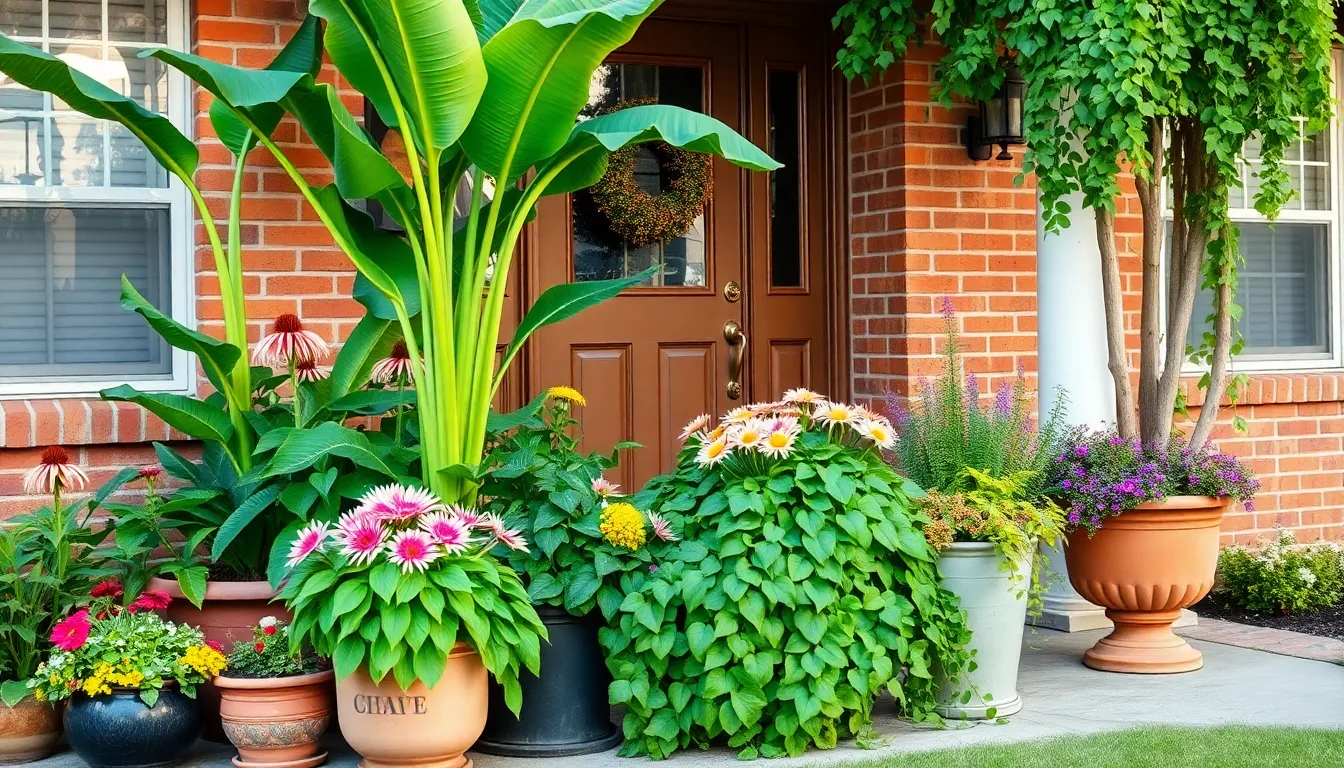
We’ll transform your front yard into a stunning focal point by mastering strategic plant arrangement techniques. Grouping pots in odd numbers creates natural visual appeal while varying container shapes and sizes draws attention to your entrance.
Use the Thriller, Filler, Spiller Method
Thriller plants serve as the dramatic centerpiece of your arrangement, commanding attention with their height and bold presence. Banana trees, palm trees, and ornamental grasses work perfectly as these show-stopping focal points. We recommend positioning these tall specimens in the center or back of your container to create maximum impact.
Filler plants occupy the middle layer, adding volume and color around your thriller. Coneflowers and heuchera excel in this role, providing consistent texture and visual weight. These medium-height plants bridge the gap between your tall centerpiece and trailing elements.
Spiller plants cascade gracefully over container edges, softening harsh lines and creating movement. Trailing ivy, pothos, and foxtail asparagus fern offer excellent spillage options. We’ve found that these flowing elements make containers appear more natural and established.
Vary Heights and Textures for Visual Interest
Structural plants paired with softer, bushier specimens create ever-changing visual compositions that catch the eye. Mixing different leaf shapes prevents monotonous displays while adding sophisticated depth. We suggest combining spiky plants like ornamental grasses with rounded forms such as boxwood spheres.
Textural contrasts elevate simple arrangements into professional-looking displays. Smooth leaves against fuzzy foliage, or glossy surfaces beside matte finishes, create captivating tactile variety. Concrete or fiberglass pots enhance these textural plays while providing stability and contemporary style.
Layered plantings using trailing vines alongside upright forms produce multi-dimensional arrangements. We’ve discovered that combining lantanas, coneflowers, and ferns in single containers creates remarkable depth and seasonal interest.
Incorporate Color Schemes That Complement Your Home
Warm color palettes featuring yellows, oranges, and reds beautifully complement brick exteriors and earthy architectural tones. These vibrant hues create welcoming entrances that draw visitors toward your front door. We recommend using plants like red salvia and orange nasturtiums for these warm schemes.
Cool color combinations using purples, pinks, and greens work exceptionally well with lighter facades and modern color palettes. These sophisticated arrangements create calming, refined appearances that enhance contemporary home designs. Evergreen shrubs like holly provide consistent green backdrops for colorful flowering additions.
Seasonal rotations keep your color schemes fresh and relevant throughout the year. Spring tulips can transition into summer succulents, followed by autumn mums and winter evergreen displays. We’ve found that planning these transitions ensures your front yard maintains visual interest across all seasons.
Position Your Front Yard Potted Plants Strategically
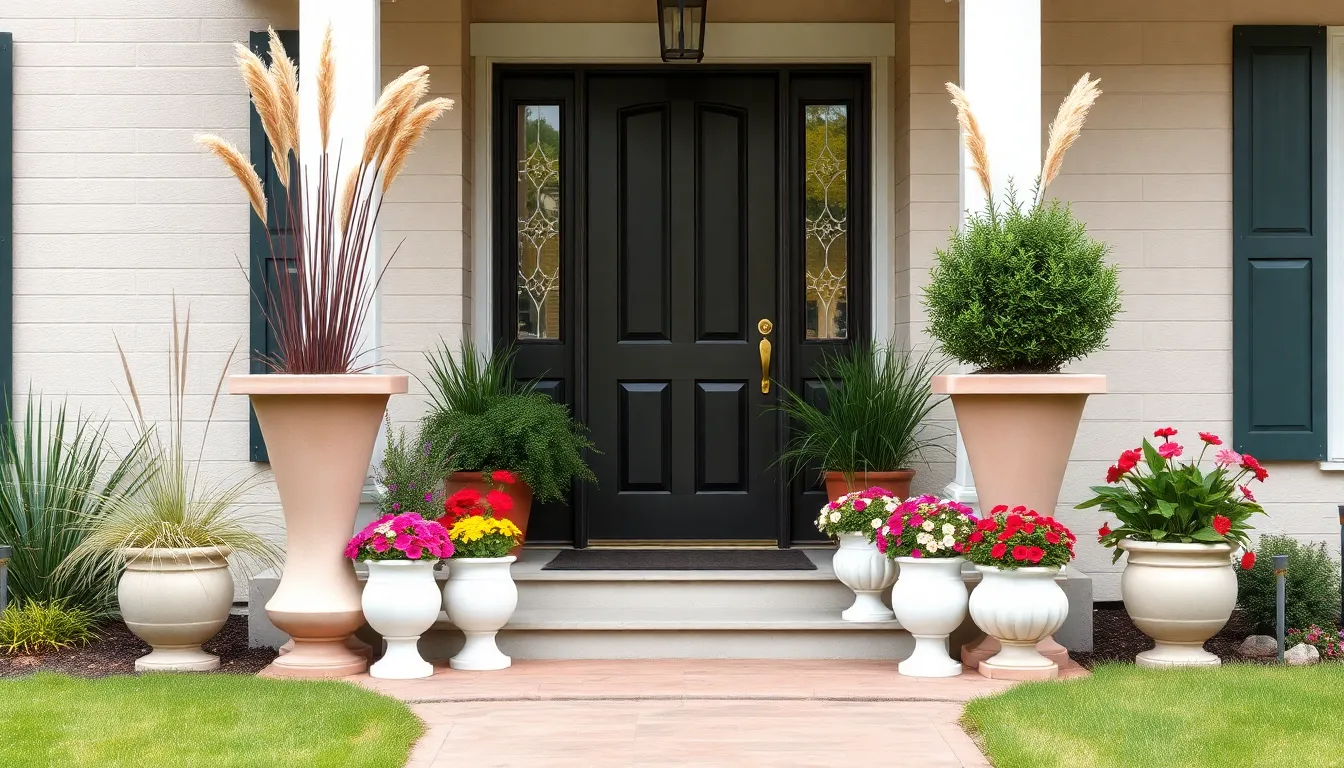
Strategic placement transforms ordinary containers into stunning focal points that enhance your home’s overall appeal. We’ll guide you through the essential positioning techniques that create maximum visual impact while ensuring your plants thrive in their designated spots.
Frame Your Entryway and Walkways
Place identical pots with matching plants on either side of your front door to create a balanced focal point that instantly boosts curb appeal. This symmetrical arrangement acts as a natural welcome mat that draws visitors toward your entrance while establishing a sense of order and elegance.
Use tall slender plants or grasses in modern monochromatic pots to frame your entryway for a sleek contemporary appearance. These vertical elements create clean lines that complement modern architecture while adding height without overwhelming smaller spaces.
Stagger pots of varying heights along walkways with trailing or upright plants to define the path naturally. This technique guides guests toward your door while adding texture and visual interest to otherwise plain concrete or stone surfaces.
Group large containers near the entryway to create a dramatic first impression that establishes your home’s personality from the street. These statement pieces anchor your design while providing space for substantial plantings that won’t get lost in the industry.
Consider Sun and Shade Requirements
Select sun loving species like succulents, lantanas, and sunpatiens for bright spots that receive six or more hours of direct sunlight daily. These heat tolerant plants thrive in containers placed along south facing walls or open areas where they can soak up maximum rays.
Choose shade tolerant plants such as ferns and pothos for areas that receive less than four hours of direct sunlight, including spots under overhangs or near large trees. These species maintain their vibrant appearance even in lower light conditions.
Rotate seasonal plants to maintain vibrant color throughout the year by switching spring bulbs like tulips and daffodils with summer succulents or heat loving annuals. This strategy ensures your front yard containers always showcase peak performance plants.
Match plant selections to your exact microclimates by observing how sunlight patterns change throughout the day in different areas of your front yard. Even small variations in exposure can significantly impact plant health and appearance.
Create Balance and Symmetry in Your Design
Use pairs of matching pots and plants for entryways to achieve formal balance that creates a polished, intentional appearance. This classic approach works particularly well with traditional architecture where symmetry reinforces the home’s established design principles.
Balance contrasting textures and colors by repeating similar elements across different areas of your front yard display. For example, if you use a bold red flowering plant in one container, echo that color in another pot positioned across the space.
Incorporate evergreen plants like boxwood or holly in key containers to provide year round structure that maintains visual balance regardless of seasonal changes. These reliable performers ensure your design remains cohesive even when seasonal plants fade or are replaced.
Vary container heights while maintaining visual cohesion by using different sized pots that share similar materials, colors, or shapes. This technique creates ever-changing interest while preventing the arrangement from appearing chaotic or unplanned.
Maintain Your Potted Plant Display Year-Round

Creating stunning front yard potted displays requires consistent care that adapts to changing seasons. We’ll guide you through the essential maintenance practices that keep your containers thriving throughout the year.
Establish a Regular Watering Schedule
Watering becomes the cornerstone of successful container gardening since potted plants dry out faster than ground plantings. We recommend checking soil moisture daily by inserting your finger about two inches deep into the potting mix. When the surface feels dry to the touch, it’s time to water thoroughly until excess water drains from the bottom holes.
During hot summer months, daily watering might become necessary as containers lose moisture rapidly in direct sunlight. Morning watering works best because it gives plants time to absorb water before the heat intensifies. We avoid watering in late afternoon or evening since wet leaves overnight can encourage fungal problems.
Different plant types require varied watering approaches throughout the seasons. Succulents need less frequent but deeper watering, while flowering annuals demand consistent moisture levels. Container plants in shaded areas typically need water every two to three days, whereas those in full sun may require daily attention during peak growing season.
Fertilize and Prune for Optimal Growth
Container plants are heavy feeders since nutrients wash out with regular watering cycles. We start by mixing time-released granular fertilizer into the potting soil at planting time for steady, slow feeding throughout the growing season. High-quality potting soil provides better nutrient retention than garden soil and creates the foundation for healthy root development.
About a month after planting, we supplement with half-strength water-soluble fertilizer every two to three weeks until the end of the growing season. Specialized potting mixes work best for exact plant types – succulents thrive in well-draining soil mixtures, while flowering plants benefit from nutrient-rich formulations designed for containers.
Regular pruning keeps plants compact, healthy, and visually appealing by removing dead or overgrown foliage. We trim spent blooms to encourage continued flowering and pinch back leggy growth to maintain attractive shapes. Strategic pruning also improves air circulation around plants, reducing the risk of disease problems in humid conditions.
Protect Plants During Extreme Weather
Extreme weather poses unique challenges for container plants since their roots are more exposed than in-ground plantings. During intense heat waves, we provide extra shade for sensitive plants using temporary structures or relocating containers to protected areas. Sufficient watering becomes critical during hot spells, sometimes requiring twice-daily irrigation for the most vulnerable specimens.
Cold weather protection involves moving frost-sensitive containers indoors or to sheltered locations like garages or covered porches. Container plants experience more dramatic temperature swings than ground plantings, making them particularly vulnerable to sudden weather changes. We wrap or insulate containers that can’t be moved, using burlap or frost cloth to protect both plants and pot materials.
Durable containers made from fiberglass or plastic reduce maintenance efforts while withstanding harsh weather conditions better than natural materials. These weather-resistant options eliminate the need for seasonal container storage and provide consistent protection for root systems throughout temperature extremes.
Enhance Curb Appeal With Seasonal Rotations
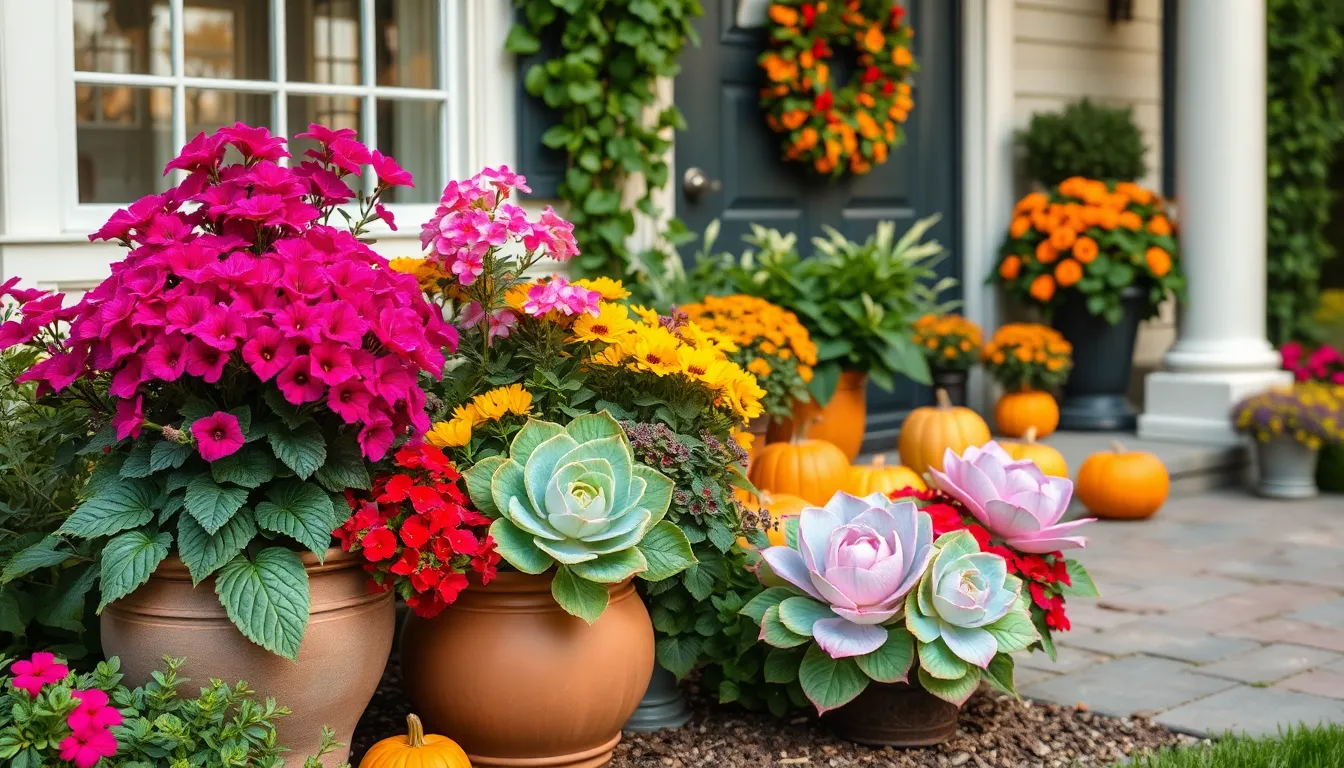
Rotating potted plants seasonally keeps our front yard fresh and visually appealing year-round. Strategic seasonal transitions ensure continuous interest while maximizing each plant’s peak performance period.
Plan Spring and Summer Displays
Spring displays should focus on vibrant, blooming plants that bring energy and life to our front entrance. Azaleas excel during these seasons with their ability to bloom in spring and sometimes rebloom in summer or fall, offering long-lasting seasonal interest with minimal maintenance requirements. These versatile shrubs thrive in partial shade near the house or under trees, making placement flexible throughout our industry design.
Container gardens filled with bright annuals create an inviting entryway atmosphere. Petunias, marigolds, and geraniums work exceptionally well in high-quality planters that frame doorways or line pathways. Hydrangeas and flowering hedges like lilac or viburnum provide colorful blooms paired with lush green foliage that persists through the entire growing season.
Strategic placement of these containers guides visitors naturally while establishing welcoming focal points. Summer arrangements benefit from heat-tolerant species that maintain their vibrant appearance even though temperature fluctuations and intense sunlight exposure.
Create Autumn Interest With Fall Plants
Autumn transitions require plants that showcase warm colors and rich seasonal textures. Chrysanthemums, ornamental cabbages, and pansies in decorative pots add essential fall hues that complement our home’s architecture. Flowering hedges and shrubs displaying vibrant fall foliage, such as certain azalea or hydrangea varieties, contribute significantly to autumnal visual interest.
Decorative elements like pumpkins or gourds placed strategically among plant containers enhance seasonal charm without overwhelming the display. Layered plantings in varied container heights soften architectural lines while marking property boundaries gently. These arrangements contribute to our overall design cohesion while celebrating autumn’s natural beauty.
Color coordination between fall plants and existing industry elements creates seamless seasonal transitions. Warm orange, deep red, and golden yellow combinations work particularly well for autumn displays.
Maintain Winter Appeal With Evergreens
Winter displays rely on evergreen plants to maintain structure and color when deciduous species become dormant. Camellias, boxwoods, and evergreen flowering hedges provide year-round texture while ensuring our front yard remains attractive during colder months. These hardy selections create subtle privacy screens and filter less attractive views without obstructing natural light.
Durable containers become essential during winter months for protecting root systems from temperature extremes. Fiberglass or high-quality weather-resistant pots withstand harsh conditions while keeping plants healthy throughout seasonal challenges. Evergreen arrangements require minimal maintenance while delivering maximum visual impact during dormant seasons.
Winter container gardens benefit from incorporating decorative elements that complement evergreen foliage. Seasonal decorations paired with structural plants create polished, inviting displays that maintain curb appeal even though challenging weather conditions.
Budget-Friendly Tips for Front Yard Container Gardens
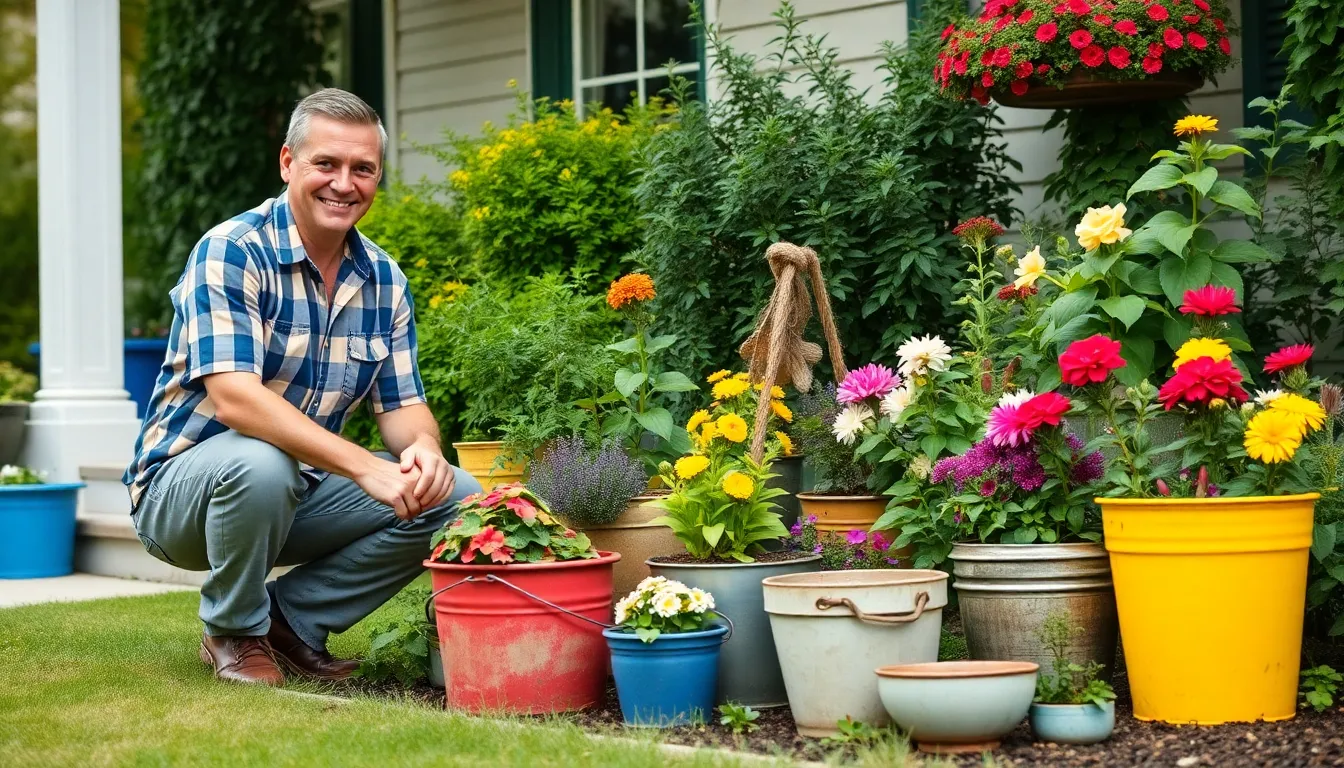
Creating stunning front yard potted displays doesn’t require very costly. Smart strategies can help you build an impressive container garden while keeping costs manageable.
Start Small and Expand Over Time
Beginning with just a few containers allows us to test what works best in our exact front yard conditions. We recommend starting with 3-5 pots to get a feel for your space’s lighting and weather patterns before investing in larger quantities. This gradual approach helps manage costs while avoiding the mistake of overwhelming your garden with too many plants at once.
Expanding your collection season by season gives you time to learn which plants thrive in your location. We can add more containers as our budget allows and our gardening confidence grows. Starting small also lets us experiment with different plant combinations without committing to expensive arrangements that might not work well together.
Propagate Plants and Share With Neighbors
Multiplying your plants through propagation saves important money on new purchases. We can take cuttings from existing plants or divide perennials to create new specimens for additional containers. Many popular front yard plants like geraniums, coleus, and herbs root easily from cuttings placed in water or moist soil.
Sharing propagated plants with neighbors creates a gardening community that benefits everyone involved. We exchange different plant varieties without spending money on new ones, building relationships while expanding our plant collections. This neighborhood plant swapping can introduce us to new species we might not have considered purchasing.
Repurpose Household Items as Planters
Transforming everyday items into unique planters adds character while reducing costs significantly. We can repurpose old buckets, ceramic sinks, baskets, and other containers we already own around the house. Adding drainage holes to these repurposed items prevents root rot and ensures proper plant health.
Thrift stores, salvage yards, and secondhand selling sites offer treasure troves of inexpensive containers with unique character. We often find vintage planters, decorative bowls, and interesting vessels that cost a fraction of new garden center prices. This eco-friendly approach reduces waste while creating distinctive displays that reflect our personal style rather than mass-produced garden aesthetics.
Conclusion
Front yard container gardening offers endless possibilities for transforming your home’s entrance into a welcoming showcase. We’ve explored everything from selecting the right pots and plants to creating stunning arrangements that complement your architecture and climate.
The beauty of this approach lies in its flexibility—you can start small and expand over time while keeping costs manageable through creative answers and seasonal rotations. Whether you’re dealing with challenging growing conditions or simply want the freedom to redesign your space regularly container gardening delivers results that enhance both curb appeal and property value.
With proper planning and maintenance your potted displays will provide year-round beauty that welcomes guests and brings joy to your daily routine. The investment in time and creativity pays dividends in creating an outdoor space that truly reflects your personal style.
Frequently Asked Questions
What are the main benefits of front yard container gardening?
Container gardening offers flexibility for seasonal changes and easy relocation, making it perfect for renters or those wanting non-permanent landscaping. It allows you to enhance your home’s curb appeal and value while adapting to different spaces, from small porches to large entrances.
What size containers work best for front yard displays?
Larger pots are recommended for stability and adequate root space. They’re less likely to tip over and provide better growing conditions for plants. Choose containers that are proportionate to your space and the mature size of your plants.
Why is drainage important in container gardening?
Proper drainage prevents waterlogging, which can kill plants by causing root rot. Always ensure your containers have drainage holes. Good drainage is essential for plant health and prevents water from stagnating in the soil.
What materials are best for outdoor containers?
Fiberglass and UV-resistant resin are excellent choices as they’re lightweight, weather-resistant, and durable. These materials withstand harsh conditions better than terra cotta or wood, which may require seasonal protection or frequent replacement.
How do I choose plants for my climate zone?
Select plants suited to your specific climate conditions. For warmer areas, choose heat-tolerant options like gomphrena and lantana. In colder climates, opt for hardy evergreens such as arborvitae and boxwoods that can withstand temperature extremes.
What is the “Thriller, Filler, Spiller” method?
This design technique uses three plant types: thriller plants as dramatic centerpieces, filler plants to add volume and color, and spiller plants that cascade over container edges. This method creates visually appealing, well-balanced arrangements with varying heights and textures.
How should I arrange containers for maximum visual impact?
Frame entryways and walkways with matching pots for balance and symmetry. Stagger containers of varying heights to guide guests naturally, and consider sun and shade requirements when placing plants. Use pairs of matching pots and repeat colors for cohesion.
How often should I water container plants?
Container plants dry out faster than ground plantings and require more frequent watering. Check daily during hot months and establish a regular watering schedule. Different plant types may have varying water needs, so adjust accordingly.
How can I maintain year-round appeal with seasonal rotations?
Plan spring and summer displays with vibrant blooming plants like petunias and geraniums. Use warm-colored chrysanthemums and ornamental cabbages for autumn, and incorporate evergreens like camellias and boxwoods for winter structure and color.
Can I create beautiful container gardens on a budget?
Yes! Start small with a few pots, propagate plants, and share with neighbors. Repurpose household items as planters and shop at thrift stores for unique containers. This eco-friendly approach keeps costs manageable while reflecting your personal style.

